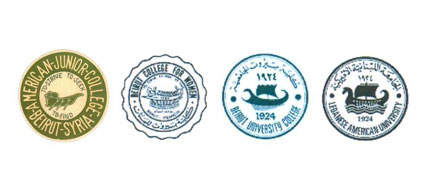LAU to unveil new visual identity
LAU is the first university in the region to undertake a branding initiative that will be implemented with the use of vivid descriptors and visual components.
![[photo]](branding-01-180.jpg)
MarCom Director Peggy Hanna (1st from right) presents the LAU branding initiative at a meeting with the School of Arts and Sciences council on the Beirut campus.
![[photo]](branding-02-180.jpg)
LAU faculty and staff participate in a focus group for the branding initiative.
Click on any photo above to view all seven images
Come January, LAU will be the first university in the region to have undertaken and implemented a branding initiative with the goal of enhancing the university’s perception, feel and identity while capturing its mission and aspirations with the help of new and revamped visual components.
The branding effort was led by LAU’s Marketing and Communications Department in partnership with Mind the Gap, a leading branding agency based in Beirut. It was successfully completed and approved by LAU’s Board of Trustees in September after 18 months of thorough assessment, research, consultation and testing with the support of the university’s upper management, and a branding task force appointed by the President’s Cabinet.
“The process to brand LAU was long, rigorous and painstakingly thorough. We considered feedback from a diverse group of constituents who offered varying perspectives,” says Richard Rumsey, LAU’s vice president for University Advancement.
“In the end, I think we succeeded at developing an image that represents the university’s unique and innovative character,” he adds.
Following its establishment in late 2007, MarCom took charge of the branding initiative after the university’s upper management directed the department to tailor an image that reflects LAU’s heritage as well as its forward-looking programs and unique opportunities.
Once unveiled, the new seal, tagline, logos, slogans and graphics will be featured on LAU publications, the website, forms, and an assortment of other products and memorabilia the university designs to help promote visual consistency.

“Branding is not only about logos, seals, colors and look. It’s also about our identity, how to bridge the gap between how people currently perceive us and how we deserve to be perceived in the minds of our stakeholders,” says Peggy Hanna, MarCom director. “We want to showcase to the outside world the points of excellence of LAU.”
While LAU is the first higher education institution in the region to undergo branding, similar initiatives have been taken by the private sector with the help of branding agencies allowing businesses and organizations to re-establish and market themselves worldwide.
Mind the Gap collaborated intimately on the project with MarCom and a special steering committee made up of LAU faculty, staff and alumni to combine the agency’s marketing and branding expertise with the committee’s solid understanding of LAU’s history and culture.
“We have very high hopes for the branding initiative to be able to shed light on the strengths and improve the perception of the university,” says Karl Bassil, creative director of Mind the Gap. “The process was very much an inside-out one where … everything was based on the university’s core values and the work in progress was being carefully assessed and validated at all times.”
“We embarked on this branding project with enthusiasm, thoroughly explored LAU and hope to have discovered its true essence,” Bassil adds.
Before developing a new brand portfolio, MarCom gathered data about the impressions and perceptions of LAU from nearly 700 stakeholders including current students, alumni, staff, faculty, prospective students and their parents through focus groups and surveys.
After collecting the information, the branding team considered the thousands of suggestions offered by the stakeholders to design and create potential taglines, logos, graphics, brand promises, and other elements of the brand portfolio to test with them.
The main challenge of the initiative, the branding team members agree, was trying to fully cater to the hundreds of stakeholders with varying, and sometimes contradicting, interests and opinions.
“The multiplicity of the stakeholders and decision makers involved in this initiative and their incredible diversity was a major complexity that had to be tackled very carefully,” says Nayla Moujaes, MarCom account manager in charge of the initiative. “But I am sure that once implemented, the result will be extremely rewarding.”
More
Latest Stories
- Into the Psychology of Justice
- Alumnus Zak Kassas on Navigation, Spoofing and the Future of GPS
- Hearing Between the Lines
- LAU Hematology Conference 2025: Advancing Science Through Interdisciplinary Exchange
- Dr. Chaouki T. Abdallah Invested as LAU’s 10th President
- LAU Guides Its Students Through the Code of Conduct
- Innovative Procedure at LAU Medical Center–Rizk Hospital Signals Hope for a Patient With a Congenital Disease
- LAU’s Inaugural PodChat Session Addresses AI Detection in the Classroom


![[photo]](branding-03-big.jpg)
![[photo]](branding-04-big.jpg)
![[photo]](branding-05-big.jpg)
![[photo]](branding-06-big.jpg)
![[photo]](branding-07-big.jpg)